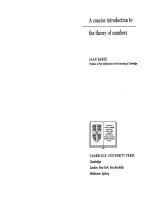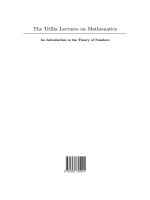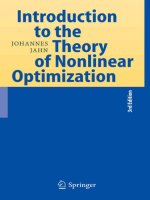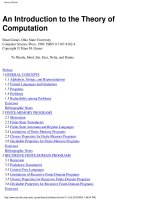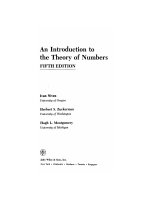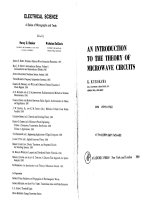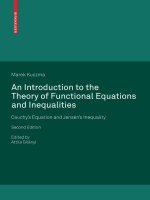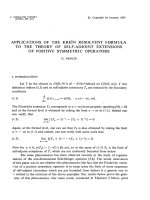- Trang chủ >>
- Khoa Học Tự Nhiên >>
- Vật lý
Application of distributions to the theory of elementary particles in quantum mechanics
Bạn đang xem bản rút gọn của tài liệu. Xem và tải ngay bản đầy đủ của tài liệu tại đây (6.69 MB, 143 trang )
Application of Distributions
to the Theory of
Elementary Particles
in Quantum Mechanics
LAURENT SCHWARTZ
Universite de Paris
GORDON AND BREACH
Science Publishers
NEW YORK. LONDON. PARIS
www.pdfgrip.com
Copyright © 1968 by Gordon and Breach, Science Publishers, Inc.
150 Fifth Avenue, New Yorkf N.Y. 10011
Library of Congress Catalog Card Number: 68-17535
Editorial Office for Great Britain:
Gordon and Breach Science Publishers Ltd.
8 Bloomsbury Way
London WCI
Editorial Office for France:
7-9 rue Emile Dubois
Paris 14
Distributed in France by:
Dunod Editeur
92 rue Bonaparte
Paris 6
Distributed in Canada by:
The Ryerson Press
299 Queen Street West
Toronto 2B, Ontario
Printed in Great Britain by Page Bros. (Norwich) Ltd.
www.pdfgrip.com
Editors' Preface
years ago when the fraternity of physicists was smaller than
the audience at a weekly physics colloquium in a major university a
J. Willard Gibbs could, after ten years of thought, summarize his ideas
on a subject in a few monumental papers or in a classic treatise. His
competition did not intimidate him into a muddled correspondence
with his favorite editor, nor did it occur to his colleagues that their own
progress was retarded by his leisurely publication schedule.
Today the dramatic phase of a new branch of physics spans less than
a decade and subsides before the definitive treatise is published. Moreover modern physics is an extremely interconnected discipline and the
busy practitioner of one of its branches must be kept aware of breakthroughs in other areas. An expository literature which is clear and
timely is needed to relieve him of the burden of wading through tentative and hastily written papers scattered in many journals.
To this end we have undertaken the editing of a new series, entitled
Documents on Modern Physics, which will make available selected reviews, lecture notes, conference proceedings, and important collections
of papers in branches of physics of special current interest. Complete
coverage of a field will not be a primary aim. Rather, we will emphasize
readability, speed of publication, and importance to students and
research workers. The books will appear in low-cost paper-covered
editions, as well as in cloth covers. The scope will be broad, the style
informal.
From time to time, older branches of physics come alive again, and
forgotten writings acquire relevance to recent developments. We expect
to make a number of such works available by including them in this
series along with new works.
SEVENTY
ELLIOTT MONTROLL
H. VINEYARD
MAURICE LEVY
GEORGE
v
www.pdfgrip.com
www.pdfgrip.com
Preface
I gave lectures in 1958 in the National University of Argentine,
Buenos-Aires, and in 1960, in the University of California, Berkeley,
on application of distributions to the study of relativistic elementary
particles. These lectures were mimeographed by the Universities
concerned; both texts are now out of print. The English text has been
translated into Russian (MIR Publications, Moscow 1964). This book
is a revised version of the Berkeley lectures notes of 1960. Therefore
it is not written and planned as a textbook. Each part was written after
the lecture had been given-hence some repetitions or even modifications in the book. This text contains a large amount of pure mathematics: theory of vector valued distributions, tensor products of
topological vector spaces, Fourier transforms and Bochner theorem,
Hilbert sub-spaces and associated kernels have been exposed as such,
but many proofs have been omitted, being intended primarily for
physicists. I tried to make a distinction between scalar valued functions
or distributions printed in normal characters, and vector valued, printed
in bold characters. But this tedious distinction has been progressively
abandoned throughout, and everything is written in normal letters,
even for vectors, except in special cases where the distinction is
important.
L. SCHWARTZ
V11
www.pdfgrip.com
www.pdfgrip.com
Contents
v
EDITORS' PREFACE
PREFACE
1.
2.
Vll
1
POSITION OF THE PROBLEM
Introduction
Elements of the Theory of Distributions
Affine Spaces: Lorentz Transformations
Universal Scalar Particles
Scalar and Vector Particles in an Arbitrary Universe
Weak and Strong Convergence
1
2
6
8
10
13
THE SET~ OF THE UNIVERSAL PARTICLES AND ITS STRUCTURE
15
15
19
26
30
33
The Space~
The Structures of~ and I£+ (E', E)
Scalar Particles
Tensor Products
Vector-valued Particles
Order Relations in Vector Spaces and Positivity of Antikernels
3.
UNIVERSAL PARTICLES AND THE TRANSLATION INVARIANCE:
KERNEL SIMPLIFICATION
Tensor Products of Distributions
Convolutions
Invariance under the Group of Translations
Fourier Transforms
Bochner's Theorem
Summary and Reduction of the Problem
The Space :¥f for Scalar Particles
4.
37
ELEMENTARY PARTICLES AND THE LORENTZ lNVARIANCE
Elementary Particles
IX
www.pdfgrip.com
42
42
44
50
56
60
63
66
68
68
CONTENTS
X
Supports of Extremal Measures
Mesons
Lorentz Invariant Distributions
Determination of all Mesons
Description of :¥f for the Meson
5. SPIN PARTICLES
Vector Particles
Determination of all Vector Particles
Complete Description of~ :¥f for Vector Particles
The Electron
Vector Particles with Zero Mass
6. DEFINITION OF SOME PHYSICAL NOTIONS
Scalar Case
Vector Case
The Intrinsic Parity
71
73
77
79
82
86
89
90
95
96
99
99
114
120
APPENDIX: Density of Probability of Presence of
Elementary Particles
123
INDEX
133
www.pdfgrip.com
CHAPTER 1
Position of the Problem
Introduction
Quantum mechanics deals with the description of motions of particles.
All the information needed for the complete description of the motion
of a particle is contained in its wave function l/f(x, y, z, t), a complex
function of position (x, y, z) E R 3 (three-dimensional Euclidean space)
and the time t. In non-relativistic quantum mechanics ll/J(x, y, z, t) 1 2 is
the probability density of the position of the particle. The probability
of the position of a particle being in a region Ac:R 3 at any time t is
JJJil/J(x, y, z, t}l 2 dxdydz. Note f/1 must be square integrable for each t
A
and we assume ~J itft(x, y, z, t)jl dx dy dz
inner product
1 for each t. If we define an
=
f!i t/t (x, y, z, t)lfl (x, y, z, t) dx dy dz, then the function
1
2
f/1 belongs to a Hilbert space for each t.
In non-relativistic quantum mechanics,
wave equation:
f/1 satisfies the Schroedinger
ih (of/1 ;at) = Hf/1
where 1f is Plank's constant divided by 2n, and H is a self-adjoint
operator in the Hilbert space L2 of square-integrable functions on R 3 •
It follows from the Schroedinger equation that the inner product of
two wave functions remains constant for all time. When the particle
is free of interaction,
fz2
H= - - 6
2m
where m is the mass of the particle and ~ is the Laplacian.
In relativistic quantum mechanics, space and time are not separate;
thus one cannot say that f/1 is a function of four variables, unless a
Lorentz coordinate system is chosen. In order to treat space and time
together, the space E 4 , a four-dimensional affine space, is introduced
and f/1 is defined on E 4 . An affine space will be defined later.
1
www.pdfgrip.com
2
STUDY OF ELEMENTARY PARTICLES
Definition. A particle, Jf, is a Hilbert space of functions on E 4 .
Definition. A motion, f/1, is an element of :¥f with Ill/Ill = 1.
Let a be an arbitrary Lorentz transformation in E 4 and G be the
Lorentz group. Under the transformation a, a function f/1 goes into a
function af/1.
Definition. If, for all a E G,
f/1 E Yf => af/1 E Yf
I a l/IIIJ(
=
lll/lll:re
then the particle, Yf, is a universal particle. In short, a universal particle
is a particle that does not change under a Lorentz transformation.
Definition. A universal particle, Yf, is elementary if :¥f contains no
subspace which transforms into itself under all aeG, i.e., :¥f is minimal.
We shall show later that the space :¥f depends on a parameter
m 0 ~ 0 and a parameter taking on the two values + and -. The +
parameter is interpreted as the charge and m0 as the rest mass of the
particle.
Definition. A meson is a scalar elementary particle (i.e., the wave
function f/1 is a scalar).
For a system of two particles, the Hilbert space has the same axioms
as before, except that its elements are functions on E 4 x E 4 . Only
systems of one free particle will be dealt with in these lectures.
For the sake of generality, we shall assume that our Hilbert space
is not a space of functions but a space of distributions.
We, therefore, begin with a short introduction to the theory of
distributions.
Elements of the Theory of Distributions
Let Rn denote the n-dimensional Euclidean space and let fl)(Rn)
(or simply fl)) be the space of all complex valued functions qJ defined
in Rn which have derivatives of all orders and which vanish identically
outside a bounded region in Rn. The functions qJ will be called testing
functions. Note that fl)(Rn) is a linear space.
We introduce now a topology in fl).
Definition. A sequence of testing functions {qJj(x)} converges to zero in
fl) if all the functions qJ j(x) vanish identically outside the same bounded
region in Rn and if the functions qJi(x) and all their derivatives converge
uniformly to zero.
www.pdfgrip.com
3
POSITION OF THE PROBLEM
Definition. A distribution T is a continuous linear functional on ~'
i.e., the image under T of an element qJ E 9} is a complex number denoted
by <T, 4>) such that
(T, (c1(/J1
+ C2({J2))
=
c1 (T, (/J1)
+ c2(T, ({J2)
and
({Ji -;
0 implies that
({Ji) --+
0.
Let ~'(Rn) (or simply ~') denote the space of distributions on Rn.
Example. Letfbe a locally integrable function in Rn.
Then
Jf(x)qJ(x) dx = AJf(x}qJ(x) dx
R"
defines a distribution. Here A is a bounded region in Rn (the support
of qJ ). Thus every locally integrable function defines a distribution.
Clearly, / 1 and / 2 define the same distribution if and only if / 1 = / 2
almost everywhere. Considering the Lebesgue classes defined by this
relation (i.e., identifying functions which are equal almost everywhere),
we conclude that the Lebesgue classes of locally integrable functions
form a subspace of the space of distributions.
Other important examples are the Dirac distribution, ~, defined by
( ~' cp) = ({J(O)
or
(~(a),
qJ)
= qJ (a)
and the dipole ' defined by
(,, qJ)
=
-
qJ'(O).
Definition. The derivative ofa distribution Tis defined by the formula:
(T', ({J) = -(T, qJ')
From this it follows that
(T<m>, ({J) = ( -l)m (T, (/J(m))
oT
ocp
uXk
uXk
( -;----, ({J)= -(T,-;-)
www.pdfgrip.com
4
STUDY OF ELEMENTARY PARTICLES
where p denotes the n-tuple of integers p = {pb ... , Pn),
IPI = P1 + · · · + Pn
and
DP =
(~)Pt (~)P2
oxl
ox2
... (~)Pn.
OXn
Thus every distribution has derivatives of all orders.
Example. Consider the Heaviside function Y(x) defined by
Y(x) = {
~
x>O
x
Then
00
(Y', cp)
J Y(x) qJ'(x) dx
= -(Y, ql) = -
-oo
00
= -
•
JqJ'(x) dx = qJ (0) = <£5, qJ)
0
Therefore Y' = £5.
Definition. Letfbe a continuous function and let A = {x :f(x} =f= 0}.
The closure A of A is called the support of the function f.
Definition. Let n be an open set in Rn and let T E ~'. We say that
T = 0 in Q if
Theorem. Let {!li} be any system of open subsets in Rn and suppose
that T = 0 in every Qi. Then T = 0 in u!li.
Proof. We must show that
is compact and covered by {!li}, there exists a finite subcover {nik},
k = 1, ... , n. Let {t/Jk}, k = 1, ... , n, be an infinitely many times continuously differentiable partition of unity on A with respect to Qik'
that is, t/J k E ~ (Rn), each t/J k has its support in Q ik and
n
L
k=l
t/Jk = 1
on A. Then
(T, (/)) = (T,
n
n
k =1
k =1
L t/Jk(/J) = L (T, t/Jk(/J) = 0.
Corollary. For every distribution T there exists exactly one maximal
open subset of Rn in which T is zero.
www.pdfgrip.com
POSITION OF THE PROBLEM
5
Proof. Consider all Qi in which T = 0. Then u Qi is the required set.
Definition. The support of T is the complement of the maximal open
subset of Rn in which T = 0.
We introduce now a topology in the space of distribution~'. Since
it is a linear space it suffices to define convergence to zero.
Definition. Weak convergence: Let {1}} be a sequence in~'. We say
that 1j converges to zero in the sense of distributions, or 1j--+ 0 in
~',if (1j, ({J) --+ 0 for every qJ E ~.
Strong convergence requires a certain uniformity and it will be
defined when needed.
Theorem. Differentiation is a continuous operation, i.e. 1j --+ 0
in p)' implies that 7j'--+ 0 in ~'.
Proof. (Tj, cp) = - (1j, cp') --+ 0 for every cp E ~.
Remarks. The weak topology defined here makes convergent a lot
of sequences which are ordinarily divergent. A series which is convergent in the sense of distributions may be differentiated term by term,
i.e., if T = L1J then T' = LT).
Theorem. Let jj--+ 0 almost everywhere and suppose that l!JI ~ g,
where g is a fixed positive locally integrable function. Then jj --+ 0 in
the sense of distributions.
Proof. This follows from the Lebesgue convergence theorem.
Example. A trigonometric series
L ak e2nikx
k
is convergent in the sense of distributions if and only if lakl ~ Aka, for
k =F 0, where A is a constant and et is some positive integer. Thus
many trigonometric series become convergent in the sense of distributions. To see this consider the series
~
4
ak
2nikx
(2nik)a.+z e
·
k=fo
It is uniformly convergent since
lakl
A
1
l2nikla+2 "" (2n)a+2 k2.
&
Therefore this series converges also in the sense of distributions. If we
differentiate now et + 2 times term by term we obtain the original
series which therefore is convergent in the sense of distributions.
www.pdfgrip.com
6
STUDY OF ELEMENTARY PARTICLES
Examples. The series
L
00
k=-
e2nikx
00
is ordinarily divergent. However, in the sense of distributions it converges to the distribution
00
L
l5(x - k)
k= -oo
£5
£5
£5
£5
£5
-1
0
1
Differentiating term by term we see that
2
-2
00
L (2nik)
e2nikx
-oo
converges to
00
L
k=-
£5'
-2
£5'
-1
l5'(x - k)
00
£5'
£5'
£5'
0
1
2
Affine Spaces: Lorentz Transformations
In the previous section we defined the space ~'(Rn) of distributions
on the Euclidean space Rn. In a similar way we may define the space
~'(En) of distributions on then-dimensional vector space En. However,
in physical space there is no pre-determined origin, so that we do not
have an En to start with. For this reason, we introduce the concept of an
affine space.
Definition. An affine space is a set E and an associated vector space E.
This association is defined by a map from E x E to E which maps a
pair a, b of elements of E to the vector a b of E, and such that the following
two laws are satisfied :
(1) Chasles' relation: If a, b, care any three elements of E, then
ab
+ be + ca
=
0.
(2) Let o be a fixed element of E. The map a --+ oa is a one-to-one
correspondence between E and E.
It should be noted that (1) may be generalized to more than three
www.pdfgrip.com
POSITION OF THE PROBLEM
7
elements. Furthermore, according to (1) the triple a,a,a yields 3 a a = 0
or a a = 0 and the triple a,a,b yields a b + ba = 0.
For obvious reasons, the notation
ab
b- d
=
is very convenient. Thus the difference between two elements a,b of E
is a map which maps the pair a,b to the vector a b of E, and which
obviously satisfies the above two laws. If a is a given element of E
and xis a given element of E, then there exists one and only one element
bEE such that a + x = b where this equality is equivalent to
x=b-a.
Definition. Let E and F be two affine spaces. The map
u:E-+F
is called an affine operator from E to F if there exists an associated
linear operator
a:E-+F
such that
(Jd- (Ja
= a(b -a).
Note that the associated linear operator a is uniquely determined
by (J. Furthermore, the composition of two affine operators is an affine
operator and the invertible affine operators form a group.
Example. The translation U : x -+ x + U is an affine operator from
the affine space E onto itself. The associated linear operator of a
translation is the identity operator,
(b
+ U)
- (a
+ U) =
b- a
Conversely, every affine operator having the identity as its associated
linear operator is a translation.
Let E be a vector space over the reals and consider a quadratic form
(xlv) defined on E. It is assumed that (xlv) is bilinear, symmetric
((xlv) = (vlx)) and non-degenerate (no element except zero is orthogonal to the whole space).
Let eb e 2 , . . . , en be an orthonormal basis in E, i.e., (eilei) = 0
fori =f j and (eilei) = + 1. Every finite dimensional vector space with a
non-degenerate quadratic form has an infinite number of orthonormal
bases. However, the number of basis elements e such that (ele) = + 1
B
www.pdfgrip.com
8
STUDY OF ELEMENTARY PARTICLES
and the number of basis elements e such that (ele) = -1 is independent
of the particular chosen basis.
Definition. The signature of an n-dimensional vector space with
respect to a given quadratic form (xI y) is the pair of integers {p, q),
where p + q = n, p is the number of O.N. basis elements e such that
(eje) = + 1 and q is the number of O.N. basis elements e such that
(eje) = -1.
Definition. A Lorentz four-dimensional vector space is a vector space
with a quadratic form which has the signature (3,1). The orthonormal
basis will be denoted by eb e 2 , e 3 , e 0 , where (eilei) = + 1, i = 1,2,3
and (e 0 Ie 0 } = -1. A Lorentz four-dimensional affine space is an
affine space E 4 whose associated vector space E4 has the signature (3,1).
By a Galilean reference system we mean a chosen origin 0 in E4 and a
chosen orthonormal basis eb e 2 , e 3 , e 0 in E4 (chosen coordinate
system).
Every point of the universe has four coordinates x 1 , x 2 , x 3 , x 0 = ct,
three of space and one of time.
Definition. A Lorentz transformation a is an affine invertible operator
in a Lorentz affine space which preserves its Lorentz structure, i.e., the
associated linear operator preserves the quadratic form
(axlav) = (xlv).
The Lorentz transformations form a group. The group G consisting of
all the Lorentz transformations (J will be called the inhomogeneous
Lorentz group, whereas the group G consisting of the associated linear
operators a will be called the homogeneous Lorentz group.
Example. Translations are Lorentz transformations.
One may now define the space ~'(E) of distributions over the affine
space E. More generally, one can define the space ~' for a manifold V,
as the space of infinitely differentiable functions with compact support,
with a suitable topology, and ~'(V), space of distributions on V, as
its dual.
Universal Scalar Particles
Now the definitions of a scalar particle and a universal particle will
be made more precise.
Definition. A scalar particle in the universe E 4 is a set :¥f satisfying
the postulates :
(1) :¥f is a vector subspace of ~'(E 4 ).
www.pdfgrip.com
POSITION OF THE PROBLEM
9
(2) :¥f is equipped with a Hilbertian structure, that is, there is a linear. .
antilinear form (t/1 1 1t/1 2 }Jf' (linear in t/1 1 and antilinear in t/1 2 ) in Je
which is Hermitian and positive definite, and :Yf is complete with
respect to the norm I t/1 IIJf' = (t/11 t/J)}e.
(3) The canonical embedding of :¥f into ~' is continuous, that is,
t/J i
--+
0 in :¥f
=>
t/J i
--+
0 in~'.
We shall find that :¥f represents charged particles. If the distributions
in E 4 were restricted to be real valued, then :¥f would describe a
neutral particle.
Definition. A motion of a particle is an element t/1 E :if such that
I t/1 I Jf' = 1.
A universal particle (universal with respect to the Lorentz group) is
one which is considered the same by different observers. An observer
makes his observations in some frame of reference; thus the particle :¥f
is interpreted by him as being a space of distributions over R 4 instead
of E 4 . If all observers interpret j'f to be the same space of distributions
over R 4 , then :¥f is a universal particle. A more precise definition is
given after the operation of (J E G on distributions is defined.
A Lorentz transformation (J E G not only operates on E 4 but also
on every structure given over E 4 . If
or, equivalently,
From the fact that a E G is a linear operator, it follows that :
Theorem.
u
(JqJ that:Theorem. <fJn --+ 0 => (J(/Jn --+ 0.
Thus (J gives an automorphism of~ onto ~.
The operation of (J on distributions is defined by the equation
((JT,
(Jt/1) = (T,
or, equivalently,
( (JT,
t/1) = ( T, (J- 1 t/J) = ( Ty, t/I((Jy).
Theorem. The operator
distributions.
(J
operates linearly and continuously on
www.pdfgrip.com
10
STUDY OF ELEMENTARY PARTICLES
Proof. Linearity:
(a(a 1 T1
+ a 2 T2 ), t/1)
=
= a1 (
(a 1 T1 + a 2 T2 , a- 1 t/l)
Tb a- 1 t/1) + a 2 ( T2 , a- 1 t/1)
+ a 2 aT2 , t/1).
Continuity: Given T,. --+ 0, then for any t/J E ~'we have a- 1 t/J E ~and
(aT,., t/1) = ( T,., a- 1 t/J) --+ 0
=
a 1 (aTb t/1)
+ a 2 (aT2 , t/1)
=
(a 1 aT1
therefore aT,. --+ 0.
It is simple to show that the operation of a followed by -r on ~' is
the same as the operation of -ra on ~'. Then it follows that a is an
automorphism of~' onto ~'.
Given an affine space E and a positive measure on E which is
invariant under translation, a measure on E is uniquely defined.
Then any locally integrable function! onE defines a distribution
(f, qJ) = Jf(x) qJ(x) dx.
Given a quadratic form on E, there corresponds orthonormal bases
and a Haar measure. In view of the fact that any a E G preserves the
quadratic form, it will also preserve the Haar measures. It follows that
a preserves the correspondence between functions and distributions for
this measure.
Given a scalar particle :¥f c~'(E 4) and any a E G, one may form
the space a Jf, the set of at/J for all t/1 E Jf. With the inner product
(at/J 1l at/J 2) u £ = (t/1 1l t/1 2)£
the space a :¥f is also a Hilbert space.
Definition. A scalar particle :¥f is universal if for all a E G the following
is true:
(1)
a:¥( =
:¥(
(2) I at/J IIJt' = II t/1 IIJt' for all t/1 E :¥f ·
It follows that :¥f is a universal particle if and only if every a E G is a
unitary operator of :¥f onto Jf.
Scalar and Vector Particles in an Arbitrary Universe
Definition. A universe V is a C 00 -manifold of finite dimension n. A
group G whose elements operate on V will be called the structure
group of the universe.
www.pdfgrip.com
POSITION OF THE PROBLEM
11
Definition. A scalar particle in the universe V is a set :¥f satisfying
the postulates:
(1) :¥f is a vector subspace of .@'(V), the space of distributions in V.
(2) :¥f is equipped with a Hilbertian structure.
(3) t/Ji --+ 0 in :¥f => t/Ji --+ 0 in .@'(V).
Definition. A scalar particle :¥f in the universe V is universal (with
respect to G) if for all (J E G :
(1) (J :¥( = :¥(
(2) I (Jt/1 IIJt' = I t/1 IIJt' for all t/1 E :¥f ·
Example. For one scalar particle, we may take V = E 4 with a given
Lorentz quadratic form and the corresponding Lorentz group as the
structure group.
Example. For two particles, we take V = E 4 x E 4 . The structure
group G is again the Lorentz group acting on E 4 x E 4 as follows:
For (x, y) E E 4 x E 4 and (J E G
(x, y)
--+
(J(X, y) =((JX, (Jy).
In order to treat particles such as the electron, proton, etc., we must
introduce the concept of a vector-valued distribution. Let F be a finite
dimensional vector space over C.
Definition. An F-valued distribution T on V is a continuous linear
map T: qJ--+ (T, qJ) of .@(V) into F.
The space .@'(V; F) of F-valued distributions on V, the space
c!t'(.@(V); F) of continuous linear maps of .@(V) into F, and the tensor
product ~'~V) ® F of .@'(V) and F are all identical:
.@'(V; F)
= c!t'(.@(V); F) = .@'(V) ® F.
Example. Let V = Rn be an affine space with a Lebesgue measure.
If f(x) is a locally integrable F-valued function on Rn, then to f corresponds a distribution
(f, qJ)
qJ --+
=
Jf(x) qJ(x) dx.
If S E .@'(V) and f E F, then the vector-valued distribution Sf E
.@'(V; F) may be defined by the equation
(Sf, ({J)
Sf is identified with S ® f
If F has the basis
E
=
(S, ({J) f.
.@'(V) ® F.
www.pdfgrip.com
12
STUDY OF ELEMENTARY PARTICLES
then T e ~'(V; F) can be written
T
where T1 , T2 ,
•• ~,
T, €
=
T1f1
~'(V).
+ T2f2 + ... + T,fn
Thus for
qJ E ~(V):
n
(T, qJ)
=
L
i= 1
Definition. An F-valued particle in the universe Vis a set :¥f c.@'(V; F)
satisfying the same postulates as a scalar particle in the universe V
except that ~'(V) is replaced by .@'(V; F) in the definition and the
following additional postulates are satisfied:
(1) Every dE G operates not only on V, but also on F, thus x E V =>
a x E V, and f E F => crf E F.
{2) If G defines the identity operation in both V and F, then a is the
identity of G.
Remark. G operates faithfully on the product V ® F, but not
necessarily on V or F alone.
Example. For an electron, G is the proper spinor group, V = E 4 ,
and F is a two-dimensional vector space over C. There is a mapping
a E G --+ a 0 E ptoper inhomogeneous Lorentz group such that two
elements of G correspond to each element in the Lorentz group, and
the action of each a on any element of E 4 is the same as the action of
the corresponding a 0 given by the mapping. There is also a mapping
a e G --+ -r E the set of unimodular operators in F, which form a group,
such that an infinite number of elements of G correspond to each
element of this group of linear operators in F, and the action of each a
on any element of F is the same as the action of the corresponding -r
given by the mapping.
Definition. The operation of a on T E .@'(V) ® F is defined by the
equation
a( ( T, qJ))
=
(aT, a
or, equivalently,
(aT, 1/1) = a( (T, a- 1 t/1)) = -r( (T,_ t/1(a 0 x))).
Definition. A universal F-valued particle in the universe Vis defined
in exactly the same way as a universal scalar particle in the universe
v.
www.pdfgrip.com
POSITION OF THE PROBLEM
13
Weak and Strong Convergence
Definition. Let E be a topological vector space. A set A c: E is
called convex if whenever x, yEA the elements ax + (1 - a)y, 0 ~a~ 1,
also belong to A. E is called locally convex if its topology can be defined
by a base consisting of convex sets.
Let E be a locally convex topological vector space and let E' be its
dual, i.e., the space of continuous linear forms on E. We shall define
weak and strong convergence in E'.
Definition. The sequence {ej} c E' converges weakly to zero, ej --+ 0
weakly, if (ej, e) --+ 0 for every e E E. Here the inner product is the one
defined naturally as being equal to the value of ej at e.
Strong convergence requires a certain uniformity on the bounded
subsets of E.
Definition. A subset A of E is called bounded if it can be mapped
into any neighborhood of zero by a contraction with a non-zero ratio.
For example, if E is a Banach space, a subset of E is bounded if it can
be mapped into any ball by a contraction with a non-zero ratio.
Definition. A sequence {ej} c E' converges strongly to zero, written
ej --+ 0 strongly, if ej, e) --+ 0 for every e E E and this convergence is
uniform on every bounded subset of E.
Let us return now to the spaces .@(V) and .@'(V) . .@(V) is the space
of testing functions defined on the universe V. If K is a compact subset
of V, let .@x(V) denote the space of testing functions whose support
is inK. In .@x(V) we may introduce the norms
<
II (/J lim = sup IDPqJ(x)l
xeK
IPI~ m
where DP denotes the {pb p2 , .. ., Pk) derivative. Just as before, we define
convergence to zero of a sequence {({Jn} in .@x(V) by requiring that
II (/Jn II m--+ 0 for all m.
An element T of .@'(V) is a linear form on .@(V) which is continuous
on every .@x(V). A sequence {1j} c .@'(V) converges weakly to zero,
1j --+ 0 weakly, if 1), qJ) --+ 0 for every qJ e .@(V). It converges strongly
to zero, 1j --+ 0 strongly, if 1), qJ) --+ 0 for every qJ E .@(V), and this
convergence is uniform on the bounded subsets of.@ x(V) for any K.
We state here without proof the following important theorem:
Theorem. The space .@'(V; F) of F-valued distributions on V is a
<
<
www.pdfgrip.com
14
STUDY OF ELEMENTARY PARTICLES
locally convex topological vector space which is complete under the
strong topology.
From this point on, our basic purpose is to find all the subspaces
:¥f of ~'(V; F), such that :¥f may be equipped with a Hilbertian
structure and convergence in :¥f implies convergence in ~'(V; F).
www.pdfgrip.com
CHAPTER 2
The Set
~of
the Universal Particles and
its Structure
The Space~
Let E be a complete locally convex topological vector space. In our
particular study, E will be .@'(V; F). Let ~ denote the set of pairs
{ Jf, (I)Jt} consisting of a linear subspace :¥f of E and a scalar product
on :¥f satisfying the following conditions :
(a) Provided with (I)Jt, :¥f is an Hilbert space;
(b) The injection of :¥f into E is continuous; that is, convergence in :¥f
implies convergence in E.
On ~ we may define the following:
(1) Multiplication by non-negative scalars, A ~ 0; the set
AJf = { :¥f if A > 0
OifA=O
If Te :¥f and therefore TE AJf, then
(2) Addition: The set
:¥f 1
+ :¥f 2 =
{T: T = T1
+ T2 ,
T1 E :¥f b
T2 E :¥f 2 }
with the norm
(3) Order: A partial ordering is defined in ~ by the relation
:¥f 1 ~ :¥f 2 if :¥f 1 c :¥f 2 and the norm in :¥f 1 is greater than or equal
to the norm in :¥f 2 .
(4) Topology: It will be shown that ~ is a closed convex cone in a
topological vector space which we shall construct.
Definition. An anti-kernel L is an anti-linear continuous map of the
15
www.pdfgrip.com
16
STUDY OF ELEMENTARY PARTICLES
dual space E' into E, that is, E /::- E', L is continuous and L(.Ae') =
"XL(e'). L is called positive if (e', Le') ~ 0 for all e' E E'. The duality
product between E and E' is defined by
(e',f) = e'(f), the value of e' atf, for feE, e' E E'.
Example. Let E = en, the n-dimensional complex vector space, then
E' = en. An anti-kernel here is a positive definite hermitian matrix L,
where
and
In the space of positive anti-kernels addition and scalar multiplication are defined in the obvious manner. Furthermore, an order relation
is given by
L 1 ~ L 2 if (e', L 1 e') ~ (e', L 2 e') for all e' E E'.
We prove now the following fundamental result:
Theorem. There is a one-to-one correspondence between the elements
:¥f of~ and the positive anti-kernels L. To :¥f E ~ corresponds the
kernel L = J . iJt . tJ, where J is the natural injection :¥f --+ E, tJ its
transposed E' --+ Yf' and iJt the canonical anti-isomorphism Jf' --+ Jf.
Proof. First we show that to a given :¥f corresponds a positive
anti-kernel L. Let e' E E'. Since e' is a continuous linear functional on E
and the injection of :¥f into E is continuous, it follows that e' is a
continuous linear functional on Jf. By the Riesz representation theorem
there is a unique element of :¥f which we shall denote by Le', such that
(e', h) = (hi Le').JF,
hE Jf,
e' E E'.
(2.1)
Clearly the map L: E' --+ :¥f c E which is defined by equation (2.1} is
anti-linear. To show that L is continuous, let ej --+ 0 in E' (strong
topology), i.e., (ej, h) --+ 0 for every hE E and uniformly for h on
bounded subsets of E. Since the injection of :¥f into E is continuous,
it follows that bounded subsets of :¥fare bounded in E. Hence (ej, h) =
(hI Lej) --+ 0 uniformly on the unit ball of Jf. Therefore I Lej I Jt --+ 0
www.pdfgrip.com
